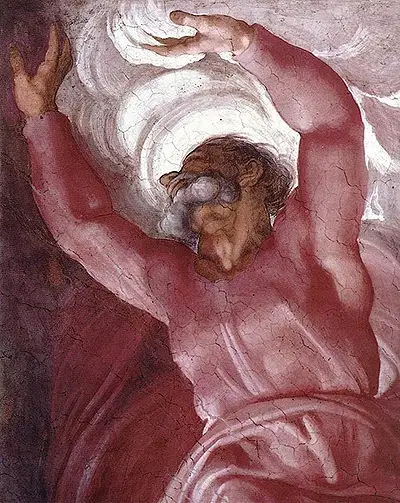Michelangelo is known for having done extensive work creating visual representation of Biblical stories and lore, and this piece is part of that theme in his body of work. As the first of these paintings, it sets the scene for the drama to come, showing the viewer the artist’s vision of how the universe began.
Naturally then, the central attraction of the piece is God, a large, muscular figure who looks capable and almost intimidating as he rips the two contrasting halves of the sky apart. The way his face is angled upward, focusing on the task at hand instead of the viewer, suggests a remoteness to him that is fitting to his grandiose being.
The actual task he is doing also does not seem particularly difficult for him. He is posed gracefully, not in a way which suggests that any kind of straining is necessary to achieve what he’s trying to do. It’s an impressive act with a lot of importance, but he is equal to it.
The swirling clouds of white and black matter also do an excellent job of representing the cosmic forces at work in the painting; there is no mistaking the grand idea they represent, but they are also ethereal enough to allow the viewer to connect with them on a primal level.
The brush strokes that are used to create them are just a little bit less smooth and polished than those used to create God, giving the sense of something raw and unrefined with tremendous power. The light clouds are also just a little bit more prominent than their dark counterparts; this makes it clear that although there must be a balance between the two forces, humanity will ultimately be living in a world dominated by light (or at least, that may be God’s hope).
Equally important as the scene itself, however, is the bold border depicting four young men relaxing on various pillars and rock sculptures that adorns the edges of the piece. Some scholars speculate that the figures are meant to be tied to the concepts of light and dark through an affiliation with night and day – those closest to the dark clouds appear drowsy while those on the opposite side appear to be engaged in activity.
If this was Michelangelo’s intention, however, it isn’t made entirely clear. Another possibility is that it is intended to ground the epic inner image in a more familiar sense of reality. Its mundane nature makes for a curious contrast to the heavenly act of creation that is going on right next to it, suggesting that perhaps we should not think of God as being solely high above us, but also right beside us and present in our everyday lives. After all, the work God is doing in the image is ultimately in the service of Man.
The figures themselves also demonstrate Michelangelo’s famed and unimpeachable grasp of the anatomy of the human body. While the four youths are not doing anything obvious to demonstrate their strength at the moment, their muscular build is wholly evident. This is common in Renaissance art, as faithful representation of the real world was seen as one of the highest artistic aspirations.
While nudity was for this reason more common than not in paintings and sculptures, the simple fact that the young men are nude and God is not might also be a signifier of the difference in nature and power between the two – God’s billowing red robe gives him a fitting air of majesty and mystery, while the humans surrounding him are clearly nothing more than ordinary men.


